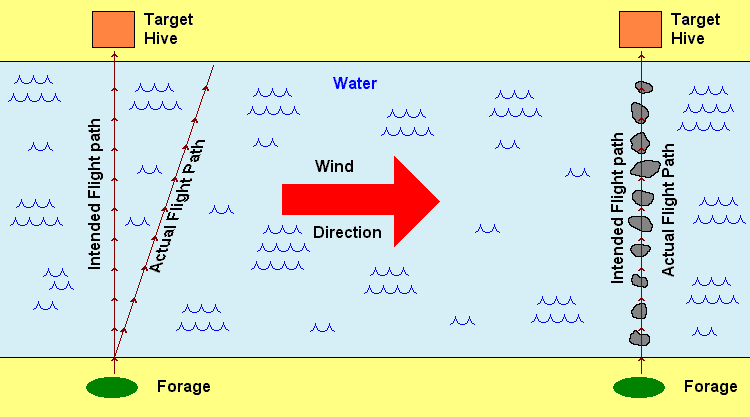Bee Behaviour - Index
Siting an Apiary.
|
|
|
|---|
|
Bee Behaviour - Index Siting an Apiary. |
Drifting Behaviour in honey bees |
|---|
Prevailing wind or repetitive features in a landscape can cause honey bees to enter a different hive from the one that they left, we call this "drifting".
 End of the line effect... During my beekeeping career I have
kept hives in various arrangements, due to the lie of the land, the
shape of the plot or my ideas at the time. The end of the line effect
is often quoted in beekeeping books as being an undesirable
situation. I am no longer sure that it is very important, but in cases
where there is a wind that prevails from a particular direction, you
will observe that the most downwind colony has the most bees and gathers more honey, the
next two or three hives along the line will also have more than the others with the opposite end
of the line being the most depleted of bees and lowest honey yield.
End of the line effect... During my beekeeping career I have
kept hives in various arrangements, due to the lie of the land, the
shape of the plot or my ideas at the time. The end of the line effect
is often quoted in beekeeping books as being an undesirable
situation. I am no longer sure that it is very important, but in cases
where there is a wind that prevails from a particular direction, you
will observe that the most downwind colony has the most bees and gathers more honey, the
next two or three hives along the line will also have more than the others with the opposite end
of the line being the most depleted of bees and lowest honey yield.
If the wind comes from two opposite directions at different times during normal flying hours and the directions are roughly in line with the line of hives, then both ends of the lines will have taller hives with the lowest in the middle of the row.
Drifting over featureless water is another classic scenario that comes up in beekeeping books time and again, the drawing below depicts two scenarios, the first where the water has no landmarks at all and the second where there is a row of stepping stones that act as fixed points for the bees navigation. In the case where the bee misses the target hive, the path from the point of landfall to the hive may be straight if the bee has knowledge of the bank, but may be a spiral search path if that information has not already been absorbed.

Patterns of placement... I started my beekeeping with hives in long rows with the entrances facing the sun. The rows were not exactly straight nor was the spacing regular. This was an attempt to reduce drifting. The bee stocks concerned were mainly Italianised mongrels.
The same mixed gene stocks have also been used two to a pallet and four to a pallet. In the latter case each hive faced a different point of the compass. The twin hive pallets had some facing east/west, some were north/south, some had both facing south and yet others were SW/SE.
More recently and with stock that is largely Amm, I face the hives outwards from my working position without any regard for compass direction.
I had a friend (now deceased), that had a great many apiaries, his method was to place 40 hives in a circle, with entrances facing outwards, and about one hive width between them. His stocks were locally naturalised Amm.
Neither he nor I ever noticed any difference in the activity or honey gathering power of any colony that could correlate with direction... Yes, there were variations in crop, but the south facing ones were no better than the rest. I do not recall any variations that were due to prevailing wind direction.
Mating Nucs on a fence... I have a paddock that is fenced in a post and rail fashion, with the vertical posts about 8 feet (2.5 m) apart. I have mating nucs at the same height on every post along two edges of the paddock. The nucs are similar to each other, but each has a distinctly different roof.
I made each of the mating nuc roofs to a different shape with three dimensional patterned blocks of various geometric shapes. The roofs are painted as well, but the only two colours used are black and white. The roof shape is painted in white and the applied blocks are painted black.
There is an inverse to drifting and that is the bees ability to find the hive after the beekeeper has moved or disturbed it. I believe that some strains or races of bee have a strong affinity for their own colony and will investigate other colonies in an attempt to find their particular 'home'. Some other strains will jump into the first colony that they come across. This may have implications in the spreading of diseases.
D.A.C
I agree with Dave Cushman's assessment of drifting. It has become an obsession with some people, especially the inexperienced ones who have taken to teaching and writing books before they have enough knowledge or experience to do so. For those who have their bees in all but the most exposed and featureless areas, I believe that drifting can be forgotten. It simply isn't a problem, so why beekeepers, beginners especially, are encouraged to waste their time on it is way beyond me, when there are far more important things to worry about. Having said that, if your bees are in an exposed place, then it would be better not to put them in a straight line, but break them up a bit by facing them in different directions and varying the gaps between them. One beekeeper with a lot of hives in a line on an exposed moor told me that drifting wasn't a problem to him. He still had the same amount of honey and it didn't matter to him which hives he took it from!
I was told by someone who was taking her BBKA General Husbandry assessment that the assessor mentioned that her 4 hives that were in a row, but spaced a reasonable distance apart, surrounded by thick hedges and trees at the bottom of her garden should be moved because of drifting!
The thinking is that disease will spread between colonies, but I think it's false logic. Surely the best thing to do is to make sure the bees are as free of disease as possible and in any case bees, drones especially, go into other hives.
Roger Patterson.
Page created 20/08/2002
Page updated 25/12/2022
Originated... 20 August 2002, Upgraded... 17 January 2006, Upgrade Completed... 20 January 2006,
|